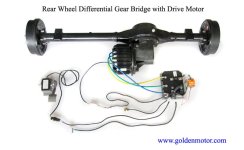Desertprep
1 kW
I have read a number of posts here about 2 motors on a 2 wheeled vehicle. My questions here are about a 4 wheeled vehicle.
The Tesla pick-up has something like 3 motors up front and 4 in the back, give or take. I would like to convert a small 4x4 vehicle like a Suzuki Tracker. If I could put one motor in the rear and one in the front, I could eliminate the driveshaft and have more room under the vehicle for storage. I think, the area that the driveshaft takes up would be ideal for storing batteries because it would be about the center of the vehicle. Search showed me a lot of people using multiple motors. I have some questions about the implementation of this: do 2 motors need 2 controllers? Or one controller designed to controller two motors? Can a switch be mounted for the driver to use the front, the rear or both? Can electric motors be mounted directly to the differential or is it better for them to have a driveshaft, even a short one? A motor from a Leaf has about the same specs as the original in the Suzuki, but more torque - always better in a 4x4. Two motors would be overkill...but fun!
The Tesla pick-up has something like 3 motors up front and 4 in the back, give or take. I would like to convert a small 4x4 vehicle like a Suzuki Tracker. If I could put one motor in the rear and one in the front, I could eliminate the driveshaft and have more room under the vehicle for storage. I think, the area that the driveshaft takes up would be ideal for storing batteries because it would be about the center of the vehicle. Search showed me a lot of people using multiple motors. I have some questions about the implementation of this: do 2 motors need 2 controllers? Or one controller designed to controller two motors? Can a switch be mounted for the driver to use the front, the rear or both? Can electric motors be mounted directly to the differential or is it better for them to have a driveshaft, even a short one? A motor from a Leaf has about the same specs as the original in the Suzuki, but more torque - always better in a 4x4. Two motors would be overkill...but fun!


